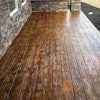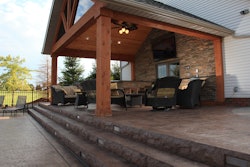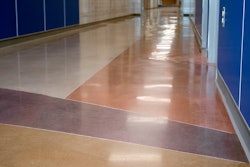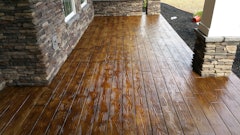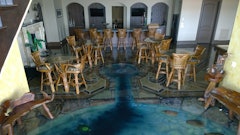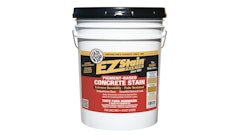
Color is no longer a specialty add-on in concrete. It has become a mainstream design feature for residential, commercial, and municipal projects alike. For contractors, that means knowing how to properly mix, dose, and finish pigmented concrete on-site is essential to delivering consistent, high-quality results.
This guide outlines best practices for pigment use in field mixing, covering dosage, sequencing, water ratios, finishing, curing, and safety.
Understanding Dosage Rates
Pigments are typically dosed at 0.75 percent to 8 percent of the cementitious weight. A dosage below 2 percent is often considered “under-toning.” Colors may appear weak or influenced by background shading from sand and aggregate.
Two percent and above (to 8 percent) ensures enough pigment coats the cement particles so the color shows without interference.
Above 8 percent is considered “saturation.” Higher loads won’t deepen color and can negatively affect the concrete matrix.
The rule of thumb is to start at 2 percent or higher for reliable color development, but never exceed 8 percent.
Estimating Bags per Yard or Meter
Pigments for contractor use are typically pre-weighed into convenient bags to simplify batching. Use printed color charts and sample kits to determine how many bags are required for the desired shade.
Key practices:
- Always pour a test sample with your mix design before committing to a project. Local aggregates, cement, finish techniques, etc., can affect color and can differ from color charts and sample kits.
- Professionally printed charts should be used as a guide in color selection. Creating a mock-up with your mix design or choosing a color from physical samples are the best ways to select a color. Never choose colors from PDFs or online swatches, as digital displays distort shade accuracy.
- Evaluate samples in the same lighting conditions as the finished project (indoor vs. outdoor).
To further support accuracy, see if your supplier offers a custom color-matching service to help develop mix designs using your customer’s cement and aggregate materials. There may be color experts on staff who might be able to provide on-site technical assistance to ensure consistent and reliable results.
Water-to-Cement Ratio and Color
Water is the most critical factor in color consistency.
- Typical w/c ratio for concrete: 0.40–0.60.
- Higher ratios: Lead to lighter, washed-out color.
- Lower ratios: Produce darker tones.
To maintain workability without diluting pigment, use a superplasticizer rather than adding excess water.  Hand troweling integrally colored ready mix concrete.Interstar Materials
Hand troweling integrally colored ready mix concrete.Interstar Materials
Pigments & Slump
Pigment itself has minimal effect on slump. Workability is controlled by the overall mix design. If adjustments are required:
- Make them at the plant before batching.
- On-site, if more slump is necessary, add plasticizers — not water.
Never add water onsite. Doing so creates inconsistency, both structurally, and aesthetically.
Sequence of Ingredient Addition
One advantage of modern granular pigments is flexibility in batching order. Pigment can be added first with the dry materials or last after other materials are in the truck. This flexibility reduces operational bottlenecks in busy plants and ensures consistent dispersion.
More about pigments and color on ForConstructionPros.comUnderstand the Differences Between Concrete Dyes, Stains and Pigments - When it comes to imparting color on a concrete surface, understanding the product options is critical in order to achieve the finished look your customer desires. Colored Concrete Trends: Choosing Between Dyes, Stains & Pigments - Understanding the differences, benefits and pitfalls of each colored concrete application is important in determining which is best for your project. The Science of Color in Concrete - Concrete is a material that varies in many ways, so achieving a perfect color is as much an art as it is science. |
Risks of Adding Water or Admixtures On-Site
Contractors should enforce a strict no on-site water addition policy.
Adding water after batching may:
- Cause dusting, cracking, and efflorescence.
- Lighten or streak color.
- Reduce the durability of the finished surface.
If admixtures are required, they should be used intentionally and consistently, not as a correction in the field.
Ensuring Color Consistency Across Loads
Consistency is achievable when there is planning and communication:
- Hold a pre-pour meeting to cover logistics, temperature, traffic, and crew readiness.
- Confirm slumps, schedules, and quantities with the concrete plant.
- Ensure loads are split evenly and sufficient volume is ordered to avoid partial “balance” loads.
- Assign enough manpower to handle the pour continuously.
Most importantly: never add water to trucks once they leave the plant.  Power troweling Black Onyx integral colored ready mix concrete.Interstar Materials
Power troweling Black Onyx integral colored ready mix concrete.Interstar Materials
Finishing Guidelines
Finishing plays a critical role in color appearance. Follow these steps:
- Place batches at the same slump (lowest workable).
- Never add water to the surface.
- Use vibrating screeds or magnesium floats; avoid long-handled Fresnos.
- Stop floating if bleed water is present — wait until it evaporates.
- Always finish surfaces within the same timeframe after placement.
- Do not use wet tools, even slightly damp ones.
- Avoid overworking; too much troweling can discolor surfaces.
For decorative applications such as stamping or exposed aggregate, seek expert input to align finishing methods with the desired aesthetic.
Curing & Sealer Application
Proper curing ensures the final color develops evenly.
Do:
- Allow at least 24–36 hours before applying a solvent-based cure and seal.
- Expect color to lighten during curing; final shade is reached after ~30 days.
- Once cured, apply a high-quality sealer to protect and preserve color.
Avoid:
- Fogging with water.
- Covering with plastic sheeting, burlap, or paper (causes spotting and discoloration).
- Shading that creates uneven curing temperatures.
Storage & Safety
Pigment products must be:
- Stored dry, in original packaging or sealed containers.
- Handled with standard PPE — dust masks, gloves, and safety glasses.
Pigments are stable materials, but like any fine particulate, they should be managed to minimize dust exposure.
Troubleshooting: Common Causes of Color Issues
- Streaks or mottling: Often due to inconsistent water addition or finishing practices.
- Light patches: May indicate excess bleed water or uneven curing.
- Inconsistent loads: Typically traced back to variations in batching or on-site adjustments.
Preventative step: Establish a standardized protocol for batching, placing, finishing, and curing on every colored job.
Integrating pigments into concrete mixes on-site is not complicated, but it requires discipline and consistency. From correct dosing to avoiding on-site water additions, each step contributes to delivering a durable, uniform, and attractive finish. With proper planning, communication, and adherence to best practices, contractors can confidently offer colored concrete as a value-added service to their clients.
